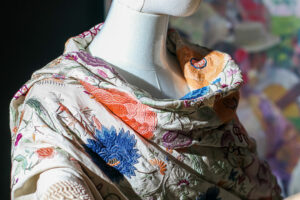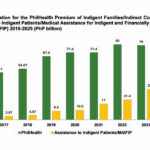
Mezcala: Interwoven Cultures and manton de manilaAn exhibit at the Ayala Museum, showing ancient specimens mantons Dating from the 1800s. More than just the beautiful shawls you can imagine, each example shows the intricate trade routes between the Spanish Empire, the Chinese Empire, and Old Manila.
At the exhibition opening on October 9, guests saw these samples of ancient silk, which were painstakingly embroidered in China, brought to the Philippines, sent to Mexico and then sent to Spain. To this day, shawls play some role in Spanish culture, seen in flamenco and jota Dancing, as well as at festivals.
Marinella Andrea Mina, curator and senior manager for research and publications at the Ayala Museum, said the collection is on loan from Veronica Duran Castello, who has been collecting them for the past 25 years and inherited some of the pieces. But due to some issues with permits regarding some of his heritage objects inlaid with ivory, these were unfortunately not on display.
Not that anything really felt missing: one of the ones we were looking for was one with Chinese motifs on a black background, a stunning one in aquamarine with bright red embroidery, while another favorite had white embroidery on a red background.
While trade between empires is evident in how some Chinese manufacturers except the Philippines adopted European motifs to appeal to their Western audiences, where do we see these?
Ms. Mina said it was only after Mexico achieved independence from Spain in 1821 that shawls began bearing the name of the capital, Manila (“the post-galeon phenomenon,” she calls it). Additionally, she says there are signs that welts, another distinguishing mark of mantonsAlways attached to Manila. According to him, there are also some examples of openwork embroidery that may indicate Philippine involvement in its creation. mantonsShe stood in front of one particular example: white silk with blue and red embroidery, which seemed to her to resemble Southeast Asian themes. batik – which may indicate participation in their creation.
Also accompanying the exhibition are the ancient boxes in which these shawls, once a luxury product, were stored – and some of Juan Luna's paintings depicting the shawls (dos buen tipos And Chulabut not very famous Mujer on Manton in Manila,
While we talk about its continued visibility Mantan In Spain, Ms. Mina said, “The Mantan exist within the scope of our study of material culture in the Philippines.” They are paintings, some depicted in film (such as in Cherry Gil). oro, plata, mata Running away from the fallen family house in black Mantan embroidered with roses), but Ms. Meena pointed out that they are still present in our dances, such as jotadifferent tempo than spanish jotaIn which shawl is also used. “The Mantan It's in our culture, but maybe not as prominent as you'll find it in Spain,” she says.
Ms Mina highlighted the importance of the exhibition: “It also shows us the complexity of relationships and the evolution of culture: whether it's material culture or practice,” she said. “We are always enriched by sharing our different traditions.”
The exhibition, a collaboration between the Ayala Museum, the Embassy of Spain, Instituto Cervantes and the Spanish Agency for International Development Cooperation (AECID), runs from Tuesday to Sunday, 11am to 7pm, until February 22, 2026 – Joseph L. Garcia










